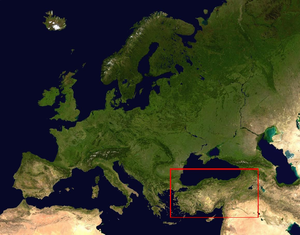Thanks to a recent study conducted by an international research team, headed up by psychologist Quentin Atkinson of the University of Auckland in New Zealand, new evidence suggests that present-day Turkey (which about 8,000 years ago was known as Anatolia) is the true origin of the Indo-European language family.
The findings of this study have generated a lot of interest amongst linguists, archeologists and other scientists in related fields because the discoveries directly oppose the common belief held by a large percentage of experts / researchers that the origin of Indo-European languages actually dates back only 6,000 years to what we now know as present-day Russia.
Atkinson and his team used computational methods to analyze a wide range of words from more than 100 ancient and contemporary languages during this recent study. The investigation, which builds upon previous work undertaken by Atkinson in 2003, also incorporated the use of geographical and historical data – an entirely new approach for Atkinson and his team – in order to further support the validity of the Anatolian hypothesis.
Michael Dunn, a linguist at the Max Planck Institute for Psycholinguistics in Nijmegen, Netherlands, explains that the commonly-accepted hypothesis (the Steppe hypothesis) is an idea which places the origin of Indo-European languages in Russia about 6,000 years.
Dunn explains that the Steppe hypothesis has been widely accepted because 6,000 years ago present-day Russia was home to the use of chariots. A constant reference to related words for “wheel” and “wagon” in most Indo-European languages connects the development of these languages to the important technological advancement of the chariot and therefore places the origin of Indo-European languages in Russia, where the use of the chariot experienced a real boom.
There are many people who are skeptical about the findings published by Atkinson and his team, including the linguist H. Craig Melchert, from the University of California, Los Angeles, who highlights the fact that most language trees relating to Indo-European languages can only be extended back a mere 7,000 years.
However, despite opposition from other experts in the field, Atkinson and his team refuse to accept that these new findings are insignificant. They analyzed 207 commonly used words across 103 ancient and modern Indo-European languages. Possible language trees were produced throughout the investigations and they were constructed using a series of estimated rates at which these Indo-European languages gained and lost cognates.
The study focused specifically on the use of cognates because cognates are examples of basic vocabulary terms that rarely get borrowed when speakers of different languages come into contact with one another.
Atkinson believes that cognates hold the key to the true origin of Indo-European languages, because when his research team combined their cognate-focused language trees with information gathered about the associated geographical locations, the appearance of Anatolian roots was the main constant, time and time again.
No doubt the debate between Anatolian and Steppe supporters will continue throughout the years to come. What is undeniable, however, is that a series of points in favor of the Anatolian hypothesis have been discovered thanks to the most recent work of Atkinson and his team.
The search continues!




